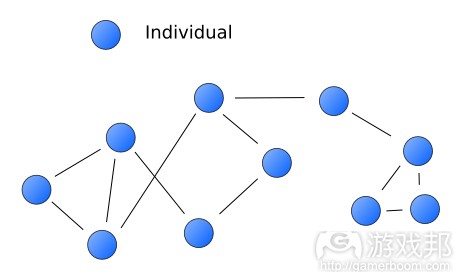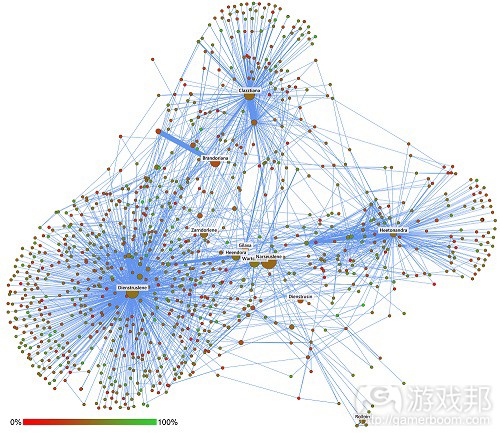分析在《命运》中与朋友一起游戏的重要性
作者:Anders Drachen
《命运》是一款混合在线射击游戏,它吸引了无数玩家在一个持久的在线虚拟环境中竞争与协作。在多人在线游戏中,玩家与社交社区间的互动在用户体验与玩家留存中扮演着非常重要的角色。此外,在游戏中创建并维持交流也是永恒的世界游戏的设计与维护的一个重要元素。
在本文中我将深入分析在《命运》里基于团队的PvP比赛(如Crucible比赛)中玩家间所形成的社交联系。因为我们还想提供一些背景内容,所以整体会显得有点冗长,但如果你觉得太长了可以先看看这些内容:
1)《命运》中表现最好的玩家总是会反复与同样的人游戏并与同样的人对抗;同时也会在这些人中组成强大且复杂的圈子,而不管这些人是否属于同样的社团。在游戏中社交联系真的扮演着非常重要的角色。
2)比起随机加入不同群组的玩家,那些在《命运》中会反复与同样的团队一起游戏或反复对抗同样团队的玩家更能有效提高自己的游戏性能。
而本文将详细介绍这些内容。
背景:社交网络分析
围绕着游戏所进行的社交联系对于用户体验来说非常重要,它们是游戏分析者在面对像《命运》等游戏时所坚持的元素,因为它们能够帮助开发者衡量如何帮助玩家创建这种联系,并判断这对于整体游戏性能的影响。即使在学术研究中,玩家间的联系也是有趣的,因为他们让我们能够去了解人类互动的本质。举个例子来说吧,游戏能够提供给研究小组有关形成过程,交流与合作的良好基础。让我们列举一个实际例子,像团队的组合以及像《魔兽世界》等游戏中的管理都是研究商业沟通和领导能力的有趣案例。关于这些游戏还有一个明显的优势便是它们允许大规模进行这类型调查,不然这通常都是很难做到的。
这是一个简单社交联系的例子。在《命运》中,蓝点代表的是玩家,当他们在PvP比赛中一起游戏或对抗时便会在彼此间连起一条线。如果一个玩家更频繁地和同样的人或特定的人游戏或对抗,那么玩家间的合作或竞争联系便会更加紧密。
有关社交联系的研究进程是以社交网络分析(SNA)的角度进行,SNA通常都将人们之间的联系作为由节点(人类)和线(联系)所组成的一张大网。然后我们可以分析这一网络中的联系,例如它们的数量,它们是否足够牢固等等。通常我们都不会将社交网络分析与这一网络中的真人的信息相结合,因为这更多地是关于联系。游戏中亦是如此。例如我们总是更倾向于分析玩家或者玩家间的联系。
而在本文中我想做些不同的尝试并结合这两种角度。我们想要探索拥有“朋友”的玩家是否会对其表现产生影响。
通常情况下在线游戏中的社交网络分析都会使用来自“朋友”列表或之类内容的信息。但是对于《命运》来说,我们希望采取不同的方式,即创建竞争网络。竞争网络是基于竞争团队间的比赛进行构建,例如Crucible比赛。因此社交网络中的联系是由那些参与了Crucible团队的玩家,或者对立队伍所组成的。当你更频繁地与同一个玩家游戏时,你与对方之间的联系便会越强大,与玩家对抗也是同样道理。
我们同样也想要了解《命运》中是否有玩家拥有强大的社交网络。这些玩家通常都对游戏中的伙伴很感兴趣,因为这将作为社交中心去吸引并留住大量玩家。团队领导者便是一个典型例子。
例如《命运》中的迷你网络便是专注于部分玩家及其之间的联系。所有的这些联系是通过玩家(有名字或匿名)间的PvP比赛所形成的。节点是玩家,他们的获胜/失败比例则是以颜色进行标记,即在红色与绿色间交替,绿色代表更高的或胜率(从从0到100%)。节点的大小则是与Crucible比赛次数相关联。连接玩家的线的厚度是随着玩家作为队友一起比赛的次数而变化的。
数据
首先我们随机采用了《命运》中1万名玩家作为样本,并让他们至少玩两个小时的游戏。这两个小时的时限将排除那些安装了游戏但是除了看到开始画面外未曾真正进入游戏中的玩家。然后我们会提取有关每个玩家玩过的每一次Crucible比赛的数据,其中也包含每个玩家的相关表现的信息。这将我们的玩家网络扩展到了将近350万(即包括超过30万的部落),其中也包含将近100万的比赛。对于每个玩家我们包含了一组性能参数以及他们的角色类别。在本文中我们将专注于获胜/失败比例以及杀戮/死亡比例,而在之后的文章中我们会进一步深入分析这些内容。我们还想详细研究一些有趣的版式,如玩家从在最初的Crucible比赛期间被特定武器类别所吸引到比赛之后转向其它武器类别等等。
PvP模式包含了各种不同的比赛活动,既有3对3也有6对6的团队比赛,但为了本文的分析我们决定将所有这些比赛类型综合在一起。所有这些数据都是在预告片“铁旗崛起”发布前所获取的。
另外,有一点让人惊讶的是,三种类别的角色分布比例其实没有差太多:Titans是29%,Warlocks是32%,Hunters是39%。这都包含了从1到40的所有关卡。
数据集中的大多数玩家的游戏次数都是在1至10次之间,有109人拥有超过1000次的比赛记录,1674人拥有超过100次的记录。换句话说,如此的比赛数量分布让我们非常惊讶,因为我们认为《命运》中的大多数玩家会经常进行Crucible比赛。
结论
我们明确了哪些玩家更有可能与同一群人一起游戏或进行对抗(游戏邦注:也就是他们拥有更强大的社会联系),以及哪些玩家更有可能和任意群组进行游戏(也就是他们拥有较弱的社交联系)。结果便是在《命运》中拥有较强社交联系的玩家在游戏中拥有更好的表现。并且比起那些社交联系薄弱的玩家他们也更倾向于玩PvP比赛。当着眼于那些玩了同样多比赛的玩家时,我们发现倾向于和相同玩家游戏或比赛的玩家的表现总是更好。所以在《命运》中拥有朋友和在生活中同样重要。
我们同样也着眼于部落成员是否会影响玩家的游戏表现。如果玩家在作为部落一员时玩了90%或更多的比赛,我们便会将其当成部落成员。而作为部落成员的确也影响着玩家的表现。此外,如果玩家更倾向于与同样的人玩游戏,他们便更有可能成为部落成员。
(本文为游戏邦/gamerboom.com编译,拒绝任何不保留版权的转发,如需转载请联系:游戏邦)
Playing with Friends in Destiny
by anders drachen
Destiny is a hybrid online shooter game that has attracted millions of players to compete or collaborate within a persistent online virtual environment. In multi-player online games, the interaction between the players and the social community that forms in them play a fundamental role in the user experience and retention of players. Moreover, building and maintaining communities in games form an important aspect for the design and maintenance of persistent-world games.
In this post we dig into the social connections formed between players in team-based PvP matches in Destiny, i.e. Crucible matches. This will be a bit wordy as we want to provide a bit of background for those interested, but if you are looking for a TLDR it is this:
1) The top performing players in Destiny – to a high degree – play with the same people repeatedly and against the same teams repeatedly; and form large intricate networks across these people, whether those people form part of the same guild or not. Social connections play a significant role in the game.
2) Playing with the same team repeatedly, or even against the same team repeatedly, increases the performance of Destiny players (win/loss ratio, kill/death ratio) as compared to those who mainly do random groups.
The details are covered in this report.
Background: Social network analysis
Because social connections in and around games are important to the user experience, they are one of the consistent ingredients in the life of a game analyst working with titles like Destiny, as is evaluating how to help players build these networks, and quantifying the effect on the overall performance of games. Even in academic research the networks formed between players have garnered interest because they allow us to investigate the nature of human interaction. For example, games provide an excellent basis for investigating group/clan formation processes, communication, and coordination. To take a very practical example, things like guild formation and –management in games like World of Warcraft are interesting case studies in research fields like business communication and leadership research. Another distinct advantage of games is that they permit these kinds of investigations at massive scales, which is otherwise difficult to do.
Example of a simple social network. In the case of Destiny, the blue dots are the players, the lines the connections formed between them as they play with or against each other in PvP matches. The more a person plays with the same people or against specific people, the stronger the collaborative or competitive link between the player and them (Image source: wikipedia).
Social connections are often investigated from the perspective of social network analysis (SNA) which essentially views the connections between people as a big network consisting of nodes (people) and links (connections). We can then analyze the connections in the network, for example in terms of their number, how strong they are, etc. It is, however, uncommon to combine social network analysis with knowledge about the actual people in the network – it is much more common to just focus on the connections. This is also the case in games. I.e. we have a tendency to either analyze the players, or the connections between the players.
In this post we wanted to do something different and combine the two perspectives. We specifically wanted to explore if playing with “friends”, i.e. the same people again and again, correlated with performance.
Normally social network analysis in an online game would be carried out using information drawn from a “friends” list or similar. However, for Destiny we wanted to go at this another way, by building competitive networks. Competitive networks are constructed based on competitive team-based play, i.e. Crucible matches. The links in the social network are thus formed with the players who form part of a Crucible team, or conversely the opposing team. The more you play with the same players the stronger your connection with them is going to be, and similar with people you play against. These connections can either be combined, so your link gets stronger the more you play either with or against another player; or we can look at links formed only with collaborative or competitive PvP play. There is more info in this report.
We also wanted to investigate whether there were players in Destiny who had big social networks. These kinds of players are usually very interesting for game companies because they help attract and retain large numbers of players simply by acting as social hubs. Guild leaders are a good example.
Example of a mini-network from Destiny, focusing on a few players and their connections. All connections formed via PvP matches between the named players are included (names are anonymized). The nodes (dots) are players, and their win/loss rate is given as a color, interpolated from red to green, with green meaning higher win-rates (from 0-100% wins). The size of the node scales with the number of Crucible matches played. The thickness of the lines connecting players scales with the number of matches the players played together as teammates.
Data
To begin with we took a random sample of 10,000 Destiny players that played the game at least two hours. The 2 hour limit was set to exclude people who installed the game but never played beyond the initial opening. Everyone also had a minimum of one Crucible match. We then extracted data covering every single Crucible match every one of these players had ever played, and also included information on the performance of every single one of these players. That brought our network of players up to almost 3.5 million (including members of over 300,000 clans), covering almost 1 million matches. For each player we included a set of performance metrics as well as their character class. In this post we fill focus on win/loss ratios and Kill/Death ratios, but in future posts we will dig into this a bit more. There are some interesting patterns we want to investigate in more detail, for example, the tendency of players to gravitate from using specific sets of weapon classes during the first few Crucible matches they play towards other weapon classes after many matches.
The PvP mode, accessed via the Crucible, covers a variety of different match-based activities played across three-versus-three to six-versus-six team-based matches, but for the purposes of this analysis we lumped all of these match types together. All the data are extracted prior to the Rise of Iron expansion.
On a side note, and hardly surprising, the distribution of characters across the three classes is roughly equal: 29% Titans, 32% Warlocks, 39% Hunters. All level ranges are included, from 1 to 40.
The vast majority of the players in the dataset played between 1-10 games, but a brave 109 had over 1000 matches recorded. 1674 had more than 100. There is, in other words, a power-law-like distribution in the number of matches played across the player base, which surprised us: we had thought more people in Destiny would be using the Crucible regularly.
Results
The actual analysis is described in excruciating detail here. Moving directly to the results, we ran experiments looking at the interplay between social connections and performance.
We identified players who have a strong tendency to play with and against the same group of people (and thus have a strong social connection with them), as well as players who had a strong tendency to play with random groups (and thus have a weak social connection with them). The results show that players with the stronger social relationships in Destiny have a higher performance: they win more matches and their Kill/Death ratios are better (not massively but still significantly). They also have a tendency to play more PvP matches than those with weaker social relationships . Looking at players who have played the same number of matches, the ones with a tendency to play with and against the same players also perform better. Friends (and enemies) are good to have in Destiny just as in real life.
We also looked at whether clan membership correlates with performance. Here we defined someone as a clan member if they played 90% or more of their matches while being a part of a clan. Being part of a clan correlates with performance as well. Additionally, if you have a higher tendency to play with the same people repeatedly, there is a larger chance you will belong to a clan.
We will write more about the temporal aspects of network formation, as well as how playstyle interrelates with social networks (do we tend to play with people who play like we do?) in the future. It should also be noted that we are working on trying to make these kinds of analyses available to players as web-based tools.
We extend our warmest regards and thanks to Bungie for their help with making data available, advice and support.
For a complete breakdown of the experimental work, see this report.
Please do not hesitate to add insights in the comments section or contact us directly with any questions. (source:gamasutra)
上一篇:有关跑酷游戏的游戏进程的研究
下一篇:如何生成《无光之空》中的世界









































 闽公网安备35020302001549号
闽公网安备35020302001549号